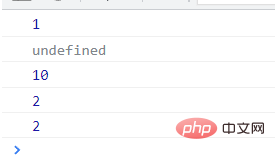
This article brings you relevant knowledge about precompilation in javascript. It mainly introduces related issues of precompilation through examples. I hope it will be helpful to everyone.

This chapter mainly talks aboutPre-compilation Process
Pre-compilation is also divided into 2 points in time:
But before the JavaScript code, the previous pre-compilation only occurs once, and the pre-compilation before function execution is multiple times.
window object , can also be understood as a GO (Global Object) object, which we cannot see (cannot print) that are not declared using var and let are placed in the GO object, and the assigned value is undefined (reminiscent of " Variable promotion")<script>
var a = 1;
console.log(a);
console.log(b);
var b = 10;
function fun (a) {
console.log(b);
var a = b = 2;
var c = 123;
console.log(a);
console.log(b);
}
var a2 = 20
fun(1);
</script>Combined with the steps mentioned above:
First, <script></script> will create a GO object (window object) before executing the code
GO = {
//自带的属性都不写
}will All declared global variables and variables not declared using var and let are placed in the GO object and assigned a value of undefined
GO = {
a : undefined,
b : undefined,
a2 : undefined
}AnalysisFunction declaration, the function name is the attribute name, and the value is the function body. If the function name and variable name are the same, they will be overwritten mercilessly
GO = {
a : undefined,
b : undefined,
a2 : undefined,
function fun (a) {
var a = b = 2;
var c = 123;
}
}This At this time, the pre-compilation process before the js code execution is completed, and the js code starts to be executed. First, a is assigned a value of 1, and corresponding changes will also be made in the GO object:
GO = {
a : 1,
b : undefined,
a2 : undefined,
function fun (a) {
var a = b = 2;
var c = 123;
}
}Then print a. At this time, the variable a will be found on the GO object, and the value of a at this time is 1, so console.log(a) is equal to 1. Then print b, and also search on the GO object, and find that the value of b is undefined, so console.log(b) is equal to undefined.
Then execute the assignment statement: b = 10; At this time, the value of b in the GO object becomes 10
GO = {
a : 1,
b : 10,
a2 : undefined,
function fun (a) {
var a = b = 2;
var c = 123;
}
}The next line of code is a **fun function, which will not be executed at this time, because in the previous pre-compilation process, actually It was placed at the front end of the code, that is, the legendary declaration was in advance, so it was ignored. Then perform the assignment operation to a2: a2 = 20, and the GO object also changes:
GO = {
a : 1,
b : 10,
a2 : 20,
function fun (a) {
var a = b = 2;
var c = 123;
}
}Then execute funFunction, such as the precompilation that occurs at another point in time mentioned above, is before the function is executed. Now let’s talk about the precompilation before the function is executed.
Function calls will also generate their own scope (**AO: **Activetion Object, execution context)AOactive object. When a function is called, it is generated a moment before execution. If there are multiple function calls, multiple AOs will be generated
undefined
If an attribute with the same name on the AO object is encountered, it will be overwritten mercilessly
Execute line by line.
The code example I took is the one above.
The first step is to create an AO object
AO{
}Findformal parametersandvariable declarationPut it into the AO object and assign it to undefined;
Note: b in the
funfunction is not declared by var, so it is a global variable , will not be placed on the AO offun.
AO{
a: undefined,//形参a与局部变量a同名
c: undefined
}Assign the actual parameter to the formal parameter
AO{
a: 1,
c: undefined,
}Search The function declaration is placed in the AO object and assigned as the function body. The fun function has no function declaration, so this step is ignored.
函数执行之前的预编译完成,开始执行语句
执行代码
首先执行打印变量b,而此时fun的AO里边并没有变量b,所以会去GO对象里边找,此时的GO对象b的值为10,所以第一行代码打印出10;
第二行代码首先要看的是b = 2,然后GO对象里边b的值就被改为2了。
GO = {
a : 1,
b : 10,
a2 : 20,
function fun (a) {
var a = b = 2;
var c = 123;
}
}然后b再赋值给a,变量a是属于局部变量a,所以fun的AO对象里边a的值被改为2。
AO{
a: 2,
c: undefined,
}接着下一个赋值语句是c = 123,所以AO对象中c的值被改为了123
AO{
a: 2,
c: 123,
}此时再执行console.log(a)的值就是AO对象里边a的值 2;执行console.log(b)的值就是GO对象b的值 2,至此函数fun执行完毕,紧跟着fun的AO也会被销毁。
综上所述,依次打印出来的值为:1,undefined,10,2,2。

undefined)imply global(暗示全局变量-专业术语) 即:任何变量,如果未经声明就赋值,则此变量就位全局变量所有。(全局域就是window,这里再一次说明了JavaScript是基于对象的语言,base on window)window的属性;var a=12;等同于window.a = 12;(会造成window这个对象特别臃肿)相关推荐:javascript学习教程、web前端开发视频教程
The above is the detailed content of Completely master the JavaScript precompilation process. For more information, please follow other related articles on the PHP Chinese website!